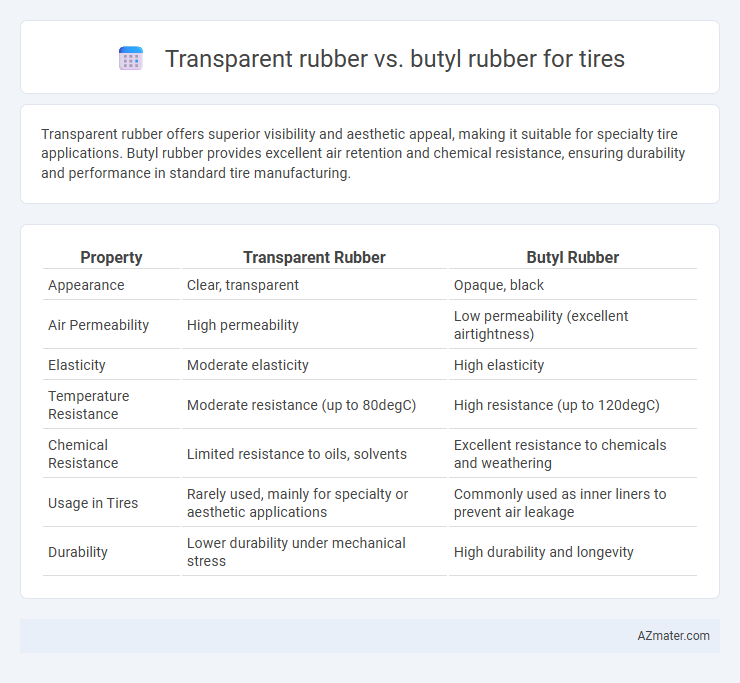Transparent rubber offers superior visibility and aesthetic appeal, making it suitable for specialty tire applications. Butyl rubber provides excellent air retention and chemical resistance, ensuring durability and performance in standard tire manufacturing.
Table of Comparison
| Property | Transparent Rubber | Butyl Rubber |
|---|---|---|
| Appearance | Clear, transparent | Opaque, black |
| Air Permeability | High permeability | Low permeability (excellent airtightness) |
| Elasticity | Moderate elasticity | High elasticity |
| Temperature Resistance | Moderate resistance (up to 80degC) | High resistance (up to 120degC) |
| Chemical Resistance | Limited resistance to oils, solvents | Excellent resistance to chemicals and weathering |
| Usage in Tires | Rarely used, mainly for specialty or aesthetic applications | Commonly used as inner liners to prevent air leakage |
| Durability | Lower durability under mechanical stress | High durability and longevity |
Introduction to Tire Rubber Materials
Transparent rubber offers clear visibility and flexibility but lacks the durability and airtight properties essential for tire applications, whereas butyl rubber is a synthetic elastomer specifically designed for tires, providing excellent impermeability to air and superior resistance to heat, chemicals, and weathering. Butyl rubber's closed structure minimizes gas permeability, making it the preferred material for inner tubes and tire liners, enhancing tire longevity and performance. The choice between these materials hinges on balancing transparency needs with mechanical strength and air retention critical to tire safety.
What is Transparent Rubber?
Transparent rubber is a type of elastomer known for its clarity and elasticity, often made from silicone or synthetic polymers that allow light to pass through without significant distortion. Unlike opaque butyl rubber commonly used in tires for its excellent air retention and chemical resistance, transparent rubber emphasizes visual properties and flexibility, making it suitable for specialized applications such as wearable devices and sensor covers. Its molecular structure is engineered to maintain transparency while providing durability, a key difference from the dense, gas-impermeable composition of butyl rubber.
Overview of Butyl Rubber
Butyl rubber, a synthetic elastomer made from isobutylene with small amounts of isoprene, is prized in tire manufacturing for its exceptional air impermeability, chemical resistance, and durability. Its unique molecular structure enables superior resistance to gas leakage compared to transparent rubber, making it ideal for inner liners in tires to maintain inflation over extended periods. Butyl rubber also offers excellent heat and weather resistance, enhancing tire longevity and performance under various environmental conditions.
Key Properties: Transparent Rubber vs Butyl Rubber
Transparent rubber offers excellent clarity and flexibility, making it suitable for specialized tire applications where visual inspection is crucial, while butyl rubber is known for superior air impermeability, excellent resistance to heat, chemicals, and aging, which enhances tire durability and performance. Butyl rubber's low gas permeability significantly reduces air loss, ensuring longer tire pressure retention, whereas transparent rubber's priority lies in aesthetics and flexibility rather than barrier properties. The choice between transparent and butyl rubber for tires depends on the balance between visibility requirements and the necessity for air retention, chemical resistance, and longevity.
Durability and Wear Resistance
Transparent rubber offers moderate durability and wear resistance but is generally less robust under high stress and abrasive conditions compared to butyl rubber. Butyl rubber excels in durability due to its excellent impermeability to air and high resistance to heat, chemicals, and abrasion, making it a preferred choice for tire inner liners and applications requiring long-lasting wear. The superior wear resistance of butyl rubber significantly extends tire lifespan, especially in demanding environments.
Air Retention Capabilities
Butyl rubber demonstrates superior air retention capabilities compared to transparent rubber, making it the preferred choice for tire inner linings due to its low gas permeability and exceptional resistance to air leakage. Transparent rubber, often used in specialized applications for visual inspection, lacks the dense molecular structure of butyl, resulting in higher permeability and reduced ability to maintain tire pressure over time. The air retention efficiency of butyl rubber significantly enhances tire durability and safety by minimizing pressure loss during driving conditions.
Environmental Impact and Sustainability
Transparent rubber, often made from polyurethane or silicone blends, offers unique sustainability benefits due to its recyclability and lower volatile organic compound (VOC) emissions during manufacturing, appealing to eco-conscious tire production. Butyl rubber, known for its superior air retention and durability, poses environmental challenges because of its petroleum-based origin and limited biodegradability, leading to concerns about long-term waste management in tire disposal. Choosing transparent rubber can reduce the ecological footprint through enhanced recyclability, while butyl rubber's environmental impact depends heavily on advancements in recycling technologies and sustainable sourcing initiatives.
Performance in Extreme Conditions
Transparent rubber offers limited applicability in tire manufacturing due to lower resistance to abrasion and heat compared to butyl rubber, which excels in extreme conditions. Butyl rubber exhibits superior impermeability to gases and exceptional durability under high temperatures and pressure, making it ideal for maintaining tire performance in harsh environments. Its excellent resistance to weathering, chemicals, and flex fatigue ensures longevity and safety in off-road and high-speed tire applications.
Cost and Manufacturing Considerations
Transparent rubber typically incurs higher manufacturing costs due to specialized processing and material purity requirements, making it less economical for large-scale tire production. Butyl rubber offers significant cost advantages with its abundant availability, straightforward manufacturing, and excellent air retention properties ideal for tire inner liners. Choosing butyl rubber reduces production expenses and enhances durability, benefiting mass-produced tire applications.
Future Trends in Tire Rubber Technology
Transparent rubber technology for tires emphasizes enhanced visibility for sensor integration and aesthetic customization, driving innovation in smart tire development. Butyl rubber remains crucial due to its superior air retention and durability, supporting advancements in longer-lasting, fuel-efficient tires. Emerging trends indicate hybrid composites combining transparent and butyl rubbers to optimize performance, transparency, and environmental sustainability in next-generation tire manufacturing.

Infographic: Transparent rubber vs Butyl rubber for Tire
 azmater.com
azmater.com